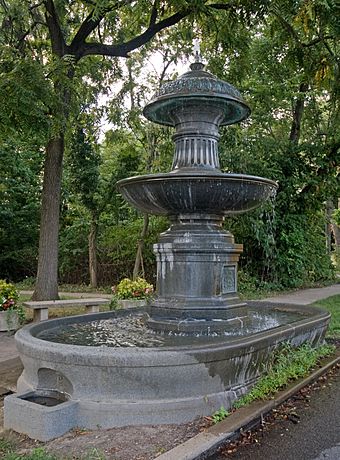Probasco Fountain facts for kids
Quick facts for kids |
|
|
Probasco Fountain
|
|
|
U.S. Historic district
Contributing property |
|

Southern side of the fountain
|
|
| Location | Clifton Ave., Cincinnati, Ohio |
|---|---|
| Area | 0 acres (0 ha) |
| Built | 1887 |
| Architect | Samuel Hannaford & Sons |
| Part of | Clifton Avenue Historic District (ID78002074) |
| MPS | Samuel Hannaford and Sons TR in Hamilton County |
| NRHP reference No. | 80003077 |
| Added to NRHP | March 3, 1980 |
The Probasco Fountain is a beautiful and historic fountain located in Cincinnati, Ohio, United States. It was built in 1887 using strong bronze and a base of granite. This special fountain was designed by a famous architect named Samuel Hannaford.
The Probasco Fountain
The Probasco Fountain stands tall at about 10 feet (3.0 m) high. It has a central column that is topped with a unique shape, like the cap of a mushroom. This design makes it stand out in the neighborhood.
Who Built It?
The fountain is named after Henry Probasco. He was a kind resident of Cincinnati who donated money to build it. Henry Probasco also gave the city another famous landmark, the Tyler Davidson Fountain. He wanted to provide useful and beautiful things for his community.
What Makes It Special?
The Probasco Fountain was created to be a drinking fountain for everyone in the Clifton neighborhood. But it wasn't just for people! It has four different basins, or bowls, for drinking. One basin was for humans, another for horses, one for dogs, and even a small one for birds. This shows how thoughtful the design was, making sure all creatures could get a drink.
A Historic Landmark
The Probasco Fountain is located on Clifton Avenue. It is part of the Clifton Avenue Historic District. This district is a special area that is listed on the National Register of Historic Places. Being on this list means the area has important historical value.
In 1980, the Probasco Fountain itself was added to the National Register of Historic Places. It was recognized along with many other buildings in Cincinnati and Hamilton County that were also designed by Samuel Hannaford. This shows how important Samuel Hannaford's work was to the city's history and architecture.



